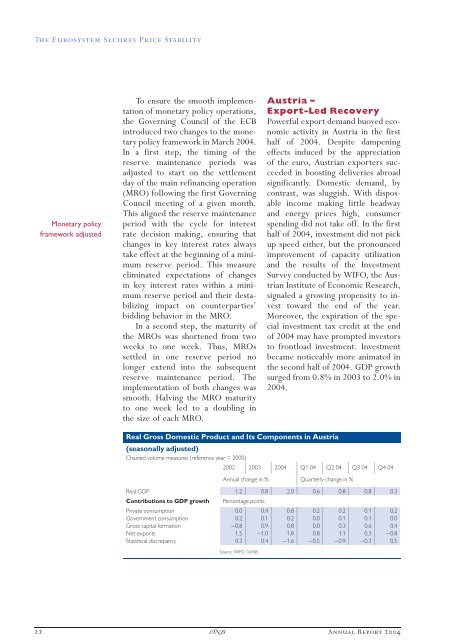Create successful ePaper yourself
Turn your PDF publications into a flip-book with our unique Google optimized e-Paper software.
The Eurosystem Secures Price Stability<br />
Monetary policy<br />
framework adjusted<br />
To ensure the smooth implementation<br />
of monetary policy operations,<br />
the Governing Council of the ECB<br />
introduced two changes to the monetary<br />
policy framework in March <strong>2004</strong>.<br />
In a first step, the timing of the<br />
reserve maintenance periods was<br />
adjusted to start on the settlement<br />
day of the main refinancing operation<br />
(MRO) following the first Governing<br />
Council meeting of a given month.<br />
This aligned the reserve maintenance<br />
period with the cycle for interest<br />
rate decision making, ensuring that<br />
changes in key interest rates always<br />
take effect at the beginning of a minimum<br />
reserve period. This measure<br />
eliminated expectations of changes<br />
in key interest rates within a minimum<br />
reserve period and their destabilizing<br />
impact on counterpartiesÕ<br />
bidding behavior in the MRO.<br />
In a second step, the maturity of<br />
the MROs was shortened from two<br />
weeks to one week. Thus, MROs<br />
settled in one reserve period no<br />
longer extend into the subsequent<br />
reserve maintenance period. The<br />
implementation of both changes was<br />
smooth. Halving the MRO maturity<br />
to one week led to a doubling in<br />
the size of each MRO.<br />
Austria —<br />
Export-Led Recovery<br />
Powerful export demand buoyed economic<br />
activity in Austria in the first<br />
half of <strong>2004</strong>. Despite dampening<br />
effects induced by the appreciation<br />
of the euro, Austrian exporters succeeded<br />
in boosting deliveries abroad<br />
significantly. Domestic demand, by<br />
contrast, was sluggish. With disposable<br />
income making little headway<br />
and energy prices high, consumer<br />
spending did not take off. In the first<br />
half of <strong>2004</strong>, investment did not pick<br />
up speed either, but the pronounced<br />
improvement of capacity utilization<br />
and the results of the Investment<br />
Survey conducted by WIFO, the Austrian<br />
Institute of Economic Research,<br />
signaled a growing propensity to invest<br />
toward the end of the year.<br />
Moreover, the expiration of the special<br />
investment tax credit at the end<br />
of <strong>2004</strong> may have prompted investors<br />
to frontload investment. Investment<br />
became noticeably more animated in<br />
the second half of <strong>2004</strong>. GDP growth<br />
surged from 0.8% in 2003 to 2.0% in<br />
<strong>2004</strong>.<br />
Real Gross Domestic Product and Its Components in Austria<br />
(seasonally adjusted)<br />
Chained volume measures (reference year = 2000)<br />
2002 2003 <strong>2004</strong> Q1 04 Q2 04 Q3 04 Q4 04<br />
<strong>Annual</strong> change in % Quarterly change in %<br />
Real GDP 1.2 0.8 2.0 0.6 0.8 0.8 0.3<br />
Contributions to GDP growth Percentage points<br />
Private consumption 0.0 0.4 0.8 0.2 0.2 0.1 0.2<br />
Government consumption 0.2 0.1 0.2 0.0 0.1 0.1 0.0<br />
Gross capital formation 0.8 0.9 0.8 0.0 0.3 0.6 0.4<br />
Net exports 1.5 1.0 1.8 0.8 1.1 0.3 0.8<br />
Statistical discrepancy 0.3 0.4 1.6 0.5 0.9 0.3 0.5<br />
Source: WIFO, OeNB.<br />
22 ×<br />
<strong>Annual</strong> <strong>Report</strong> <strong>2004</strong>
















